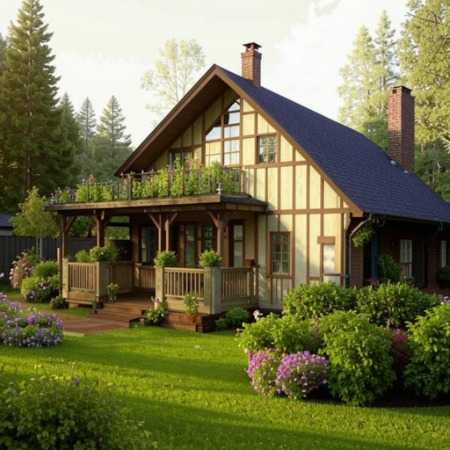A roof waterproofing membrane is a crucial component of modern roofing systems that protects the building from moisture penetration, condensation, and atmospheric precipitation. In climates with significant precipitation and temperature fluctuations, the correct choice and proper installation of waterproofing membranes play a decisive role in the roof’s durability and reliability.
This article provides an in-depth look at what a roof waterproofing membrane is, its types and characteristics, purpose and functions, selection features depending on roof type and climate, installation technologies, and common mistakes to avoid. Special attention is given to comparative analysis of popular materials and modern innovations.
The article is intended for roofers, builders, designers, and homeowners seeking a comprehensive understanding of waterproofing membranes and their role in roofing structures.
What is a Roof Waterproofing Membrane and Its Main Functions
A waterproofing membrane is a thin yet durable material laid under the roofing or insulation to prevent moisture ingress into the structure. Its primary task is to protect insulation and structural elements from condensation, rainwater, snow, and wind-driven moisture.
The membrane must be waterproof while allowing vapor permeability so that moisture formed inside can escape. This prevents moisture accumulation, mold growth, and material decay.
Additionally, the membrane acts as a barrier against dust, wind, and fine particles, improving the roof space microclimate and extending insulation life.
Types of Roof Waterproofing Membranes and Their Characteristics
The market offers a wide range of waterproofing membranes differing in material, structure, functional properties, and applications. Main types include polyethylene, polypropylene, bituminous, and composite membranes.
Polyethylene membranes are the most affordable and common, featuring high waterproofness but low vapor permeability. They are often used where ventilation is adequate.
Polypropylene membranes have high vapor permeability and strength, effectively allowing vapor to escape and preventing condensation. These are often called diffusion membranes.
Bituminous membranes have a bitumen coating, providing enhanced waterproofness and mechanical resistance but lower vapor permeability.
Composite membranes combine multiple layers of different materials to balance waterproofness, vapor permeability, UV resistance, and mechanical durability.
Functions of the Waterproofing Membrane in the Roofing System
The membrane serves as a barrier against liquid moisture, preventing rain and meltwater from entering the structure, vital for flat and pitched roofs where moisture ingress risk is high.
It also ensures vapor barrier or vapor permeability depending on membrane type, preventing condensation inside insulation and wood, thus avoiding mold and rot.
The membrane protects insulation from wind and dust, which can reduce thermal efficiency. Sometimes it acts as temporary protection during construction.
Overall, it increases roof durability by reducing corrosion and decay risks.
Selection Features Based on Roof Type
Membrane choice depends on roof type and construction. Pitched roofs with good ventilation use diffusion membranes that allow vapor escape.
Flat roofs with limited ventilation require membranes with high waterproofness and low vapor permeability to prevent moisture ingress and vapor accumulation.
Metal roofs need membranes resistant to mechanical damage and condensation due to metal’s rapid cooling.
Mansard roofs require membranes with high elasticity and strength due to complex geometry and flashing needs.
Technical Characteristics and Their Impact on Performance
Key characteristics include waterproofness, vapor permeability, tensile strength, UV resistance, operating temperature range, and durability.
Waterproofness is measured by water column height, indicating moisture resistance.
Vapor permeability shows how well vapor escapes, critical to prevent condensation.
Tensile strength ensures resistance to mechanical damage during installation and use.
UV resistance maintains properties under sunlight exposure.
Operating temperature range defines climate suitability.
Durability depends on all these factors and affects roof lifespan.
Installation Technologies: Steps and Features
Installation requires strict adherence to ensure membrane effectiveness. The substrate must be clean, dry, and smooth.
Membrane rolls are laid along the slope with overlaps of 10-15 cm for seam tightness. Fastening uses staples, nails with wide heads, or special fasteners.
Special attention to flashing and penetrations is critical, with sealing tapes or sealants used for tightness.
Diffusion membranes must be laid in the correct direction indicated by arrows.
After installation, inspect for damage and ensure ventilation gaps if required.
Common Mistakes and Their Consequences
Incorrect membrane choice can lead to condensation and decay, e.g., using non-breathable membranes on insulated pitched roofs.
Insufficient overlap or poor fastening causes leaks and reduces waterproofing.
Ignoring flashing and joint sealing causes structural water damage.
Lack of ventilation with vapor-permeable membranes leads to moisture buildup.
Using poor-quality materials and lack of quality control shorten membrane life.
Modern Innovations and Trends
Advances focus on membranes with improved vapor permeability, elasticity, UV and mechanical resistance.
Multilayer membranes integrate wind and moisture barriers with anti-condensation properties.
Eco-friendly materials safe for health and environment are increasingly developed.
Integration with smart home systems and humidity sensors enables real-time roof condition monitoring.
Comparative Analysis of Popular Membranes
| Membrane Type | Waterproofness | Vapor Permeability | Tensile Strength | UV Resistance | Service Life (years) | Recommended Use |
|---|---|---|---|---|---|---|
| Polyethylene | Very High | Low | Medium | Low | 5-8 | Temporary protection, non-breathable |
| Polypropylene | High | High | High | High | 15-25 | Pitched roofs with insulation |
| Bituminous | Very High | Low | High | Medium | 10-15 | Flat roofs, enhanced protection |
| Composite | High | Medium | High | High | 20+ | Universal application |
Conclusion
Roof waterproofing membranes are indispensable for roof durability and reliability. Correct selection based on roof type, climate, and technical specs, alongside proper installation, prevents moisture problems and condensation.
Modern materials and innovations enhance membrane efficiency, durability, and eco-friendliness. Regular inspection and timely maintenance ensure lasting protection and occupant comfort.

